YAMAHA FX SHO 2012 Owners Manual
Manufacturer: YAMAHA, Model Year: 2012, Model line: FX SHO, Model: YAMAHA FX SHO 2012Pages: 116, PDF Size: 4.49 MB
Page 91 of 116
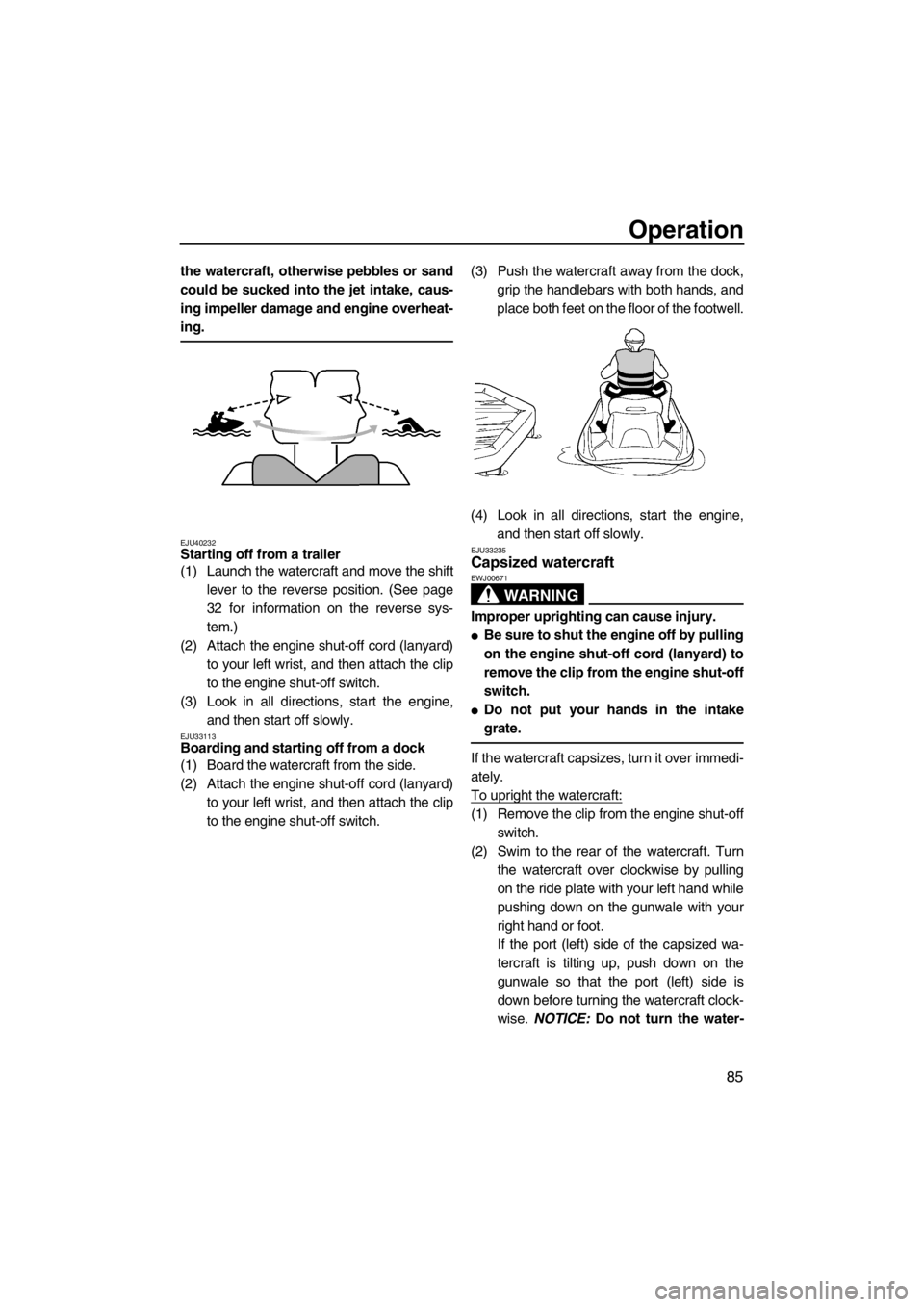
Operation
85
the watercraft, otherwise pebbles or sand
could be sucked into the jet intake, caus-
ing impeller damage and engine overheat-
ing.
EJU40232Starting off from a trailer
(1) Launch the watercraft and move the shift
lever to the reverse position. (See page
32 for information on the reverse sys-
tem.)
(2) Attach the engine shut-off cord (lanyard)
to your left wrist, and then attach the clip
to the engine shut-off switch.
(3) Look in all directions, start the engine,
and then start off slowly.
EJU33113Boarding and starting off from a dock
(1) Board the watercraft from the side.
(2) Attach the engine shut-off cord (lanyard)
to your left wrist, and then attach the clip
to the engine shut-off switch.(3) Push the watercraft away from the dock,
grip the handlebars with both hands, and
place both feet on the floor of the footwell.
(4) Look in all directions, start the engine,
and then start off slowly.
EJU33235Capsized watercraft
WARNING
EWJ00671
Improper uprighting can cause injury.
●Be sure to shut the engine off by pulling
on the engine shut-off cord (lanyard) to
remove the clip from the engine shut-off
switch.
●Do not put your hands in the intake
grate.
If the watercraft capsizes, turn it over immedi-
ately.
To upright the watercraft:
(1) Remove the clip from the engine shut-off
switch.
(2) Swim to the rear of the watercraft. Turn
the watercraft over clockwise by pulling
on the ride plate with your left hand while
pushing down on the gunwale with your
right hand or foot.
If the port (left) side of the capsized wa-
tercraft is tilting up, push down on the
gunwale so that the port (left) side is
down before turning the watercraft clock-
wise. NOTICE: Do not turn the water-
UF2S70E0.book Page 85 Wednesday, December 7, 2011 3:56 PM
Page 92 of 116
![YAMAHA FX SHO 2012 Owners Manual Operation
86
craft over counterclockwise,
otherwise water can enter the engine,
which can result in severe damage.
[ECJ00541]
(3) Start the engine and operate the water-
craft at planing speed to drai YAMAHA FX SHO 2012 Owners Manual Operation
86
craft over counterclockwise,
otherwise water can enter the engine,
which can result in severe damage.
[ECJ00541]
(3) Start the engine and operate the water-
craft at planing speed to drai](/img/51/49838/w960_49838-91.png)
Operation
86
craft over counterclockwise,
otherwise water can enter the engine,
which can result in severe damage.
[ECJ00541]
(3) Start the engine and operate the water-
craft at planing speed to drain the bilge
water from the engine compartment.
(See page 61 for information on draining
the bilge water. If the engine does not
start, see “Towing the watercraft” on
page 106 or “Submerged watercraft” on
page 107.) NOTICE: Do not run the en-
gine at full throttle for at least 1 minute
after the engine has been restarted.
Bilge water in the engine compart-
ment can splash into the engine,
which can result in severe damage.
[ECJ00553]EJU42590
Beaching and docking the watercraft
To beach the watercraft:
(1) Make sure that there are no boats, swim-
mers, or obstacles near the beach.
(2) Release the throttle lever to reduce
speed about 110 m (360 ft) before you
reach the intended beaching area.
(3) Slowly approach the beach and stop the
engine just before reaching land.
WARNING! You need throttle to steer.
Shutting the engine off can cause you
to hit an obstacle you are attempting
to avoid. A collision could result in se-
vere injury or death.
[EWJ00601] NOTICE:
Never run the engine in water that is
less than 60 cm (2 ft) deep from the
bottom of the watercraft, otherwise
pebbles or sand could be sucked into
the jet intake, causing impeller dam-
age and engine overheating.
[ECJ00472]
(4) Get off the watercraft and pull it up on the
beach.
To dock the watercraft:
(1) Make sure that there are no boats, swim-
mers, or obstacles near the dock.
(2) Release the throttle lever to reduce
speed about 110 m (360 ft) away from the
dock.
(3) Slowly approach the dock and stop the
engine just before coming alongside it.
WARNING! You need throttle to steer.
Shutting the engine off can cause you
to hit an obstacle you are attempting
to avoid. A collision could result in se-
vere injury or death.
[EWJ00601]
(4) Come alongside the dock and get off the
watercraft.
EJU37193Operating in weeded areas
Always avoid using your watercraft in areas
where weed growth is thick. If operating in
UF2S70E0.book Page 86 Wednesday, December 7, 2011 3:56 PM
Page 93 of 116

Operation
87
weeded areas is unavoidable, alternately
squeeze the throttle lever and relax your grip
on the throttle lever to vary the engine speed.
Weeds tend to become clogged more when
operating at a steady speed and at trolling
speed. If weeds may have clogged the intake
area, clean the jet intake. (See page 102 for
information on the jet intake.)
EJU40241After removing the watercraft from the
water
NOTICE
ECJ01310
Do not run the engine over 4000 r/min on
land. Also, do not run the engine for more
than 15 seconds without supplying water,
otherwise the engine could overheat.
After operating and removing the watercraft
from the water, promptly discharge the re-
maining water from the cooling water passag-
es.
To discharge water from the cooling water
passages:
(1) Make sure that the area around the wa-
tercraft is clear, and then start the engine.
(2) Discharge the remaining water out of the
cooling water passages by alternately
squeezing and releasing the throttle lever
quickly for 10 to 15 seconds.
(3) Stop the engine.
UF2S70E0.book Page 87 Wednesday, December 7, 2011 3:56 PM
Page 94 of 116
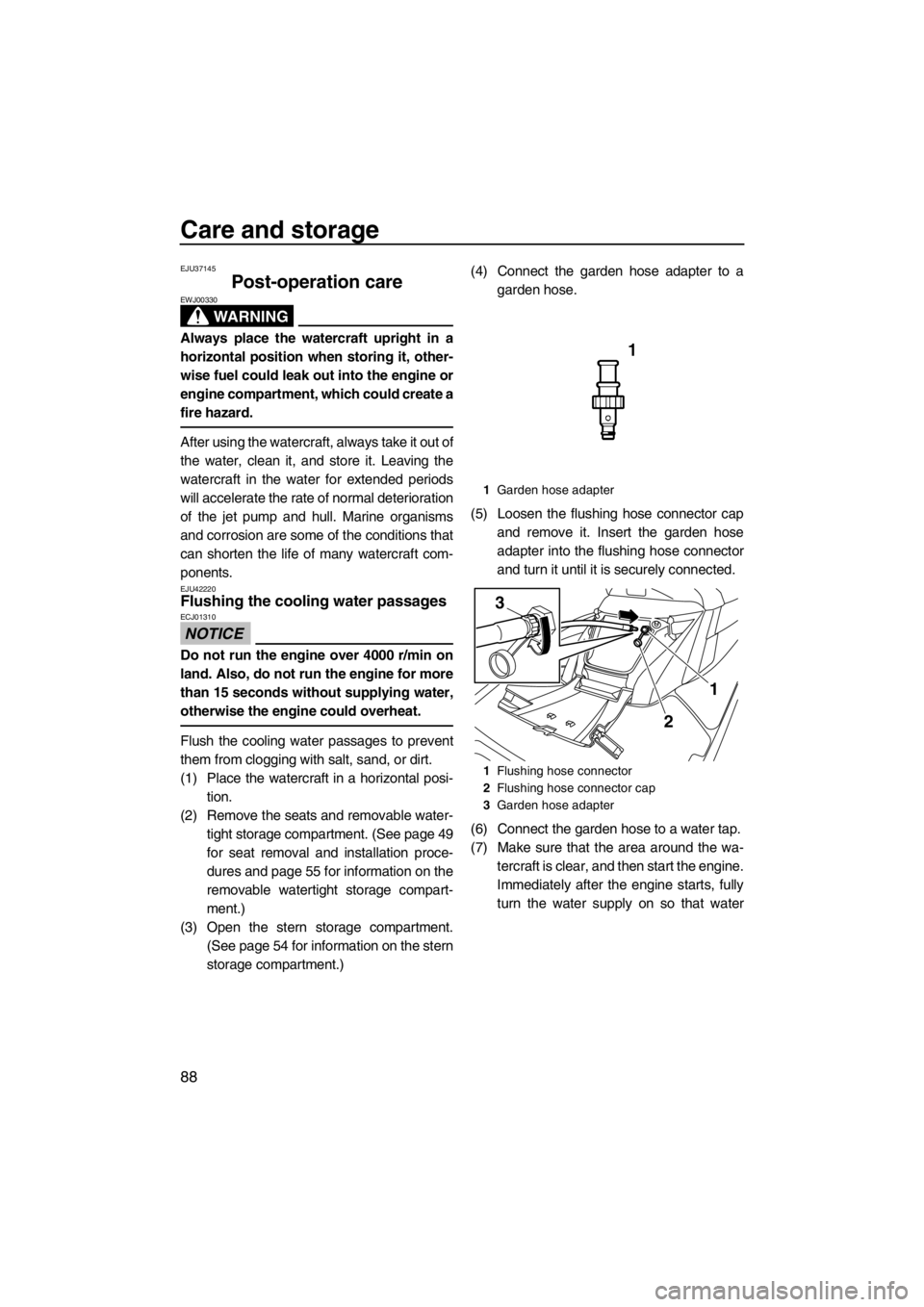
Care and storage
88
EJU37145
Post-operation care
WARNING
EWJ00330
Always place the watercraft upright in a
horizontal position when storing it, other-
wise fuel could leak out into the engine or
engine compartment, which could create a
fire hazard.
After using the watercraft, always take it out of
the water, clean it, and store it. Leaving the
watercraft in the water for extended periods
will accelerate the rate of normal deterioration
of the jet pump and hull. Marine organisms
and corrosion are some of the conditions that
can shorten the life of many watercraft com-
ponents.
EJU42220Flushing the cooling water passages
NOTICE
ECJ01310
Do not run the engine over 4000 r/min on
land. Also, do not run the engine for more
than 15 seconds without supplying water,
otherwise the engine could overheat.
Flush the cooling water passages to prevent
them from clogging with salt, sand, or dirt.
(1) Place the watercraft in a horizontal posi-
tion.
(2) Remove the seats and removable water-
tight storage compartment. (See page 49
for seat removal and installation proce-
dures and page 55 for information on the
removable watertight storage compart-
ment.)
(3) Open the stern storage compartment.
(See page 54 for information on the stern
storage compartment.)(4) Connect the garden hose adapter to a
garden hose.
(5) Loosen the flushing hose connector cap
and remove it. Insert the garden hose
adapter into the flushing hose connector
and turn it until it is securely connected.
(6) Connect the garden hose to a water tap.
(7) Make sure that the area around the wa-
tercraft is clear, and then start the engine.
Immediately after the engine starts, fully
turn the water supply on so that water
1Garden hose adapter
1Flushing hose connector
2Flushing hose connector cap
3Garden hose adapter
1
3
2
UF2S70E0.book Page 88 Wednesday, December 7, 2011 3:56 PM
Page 95 of 116
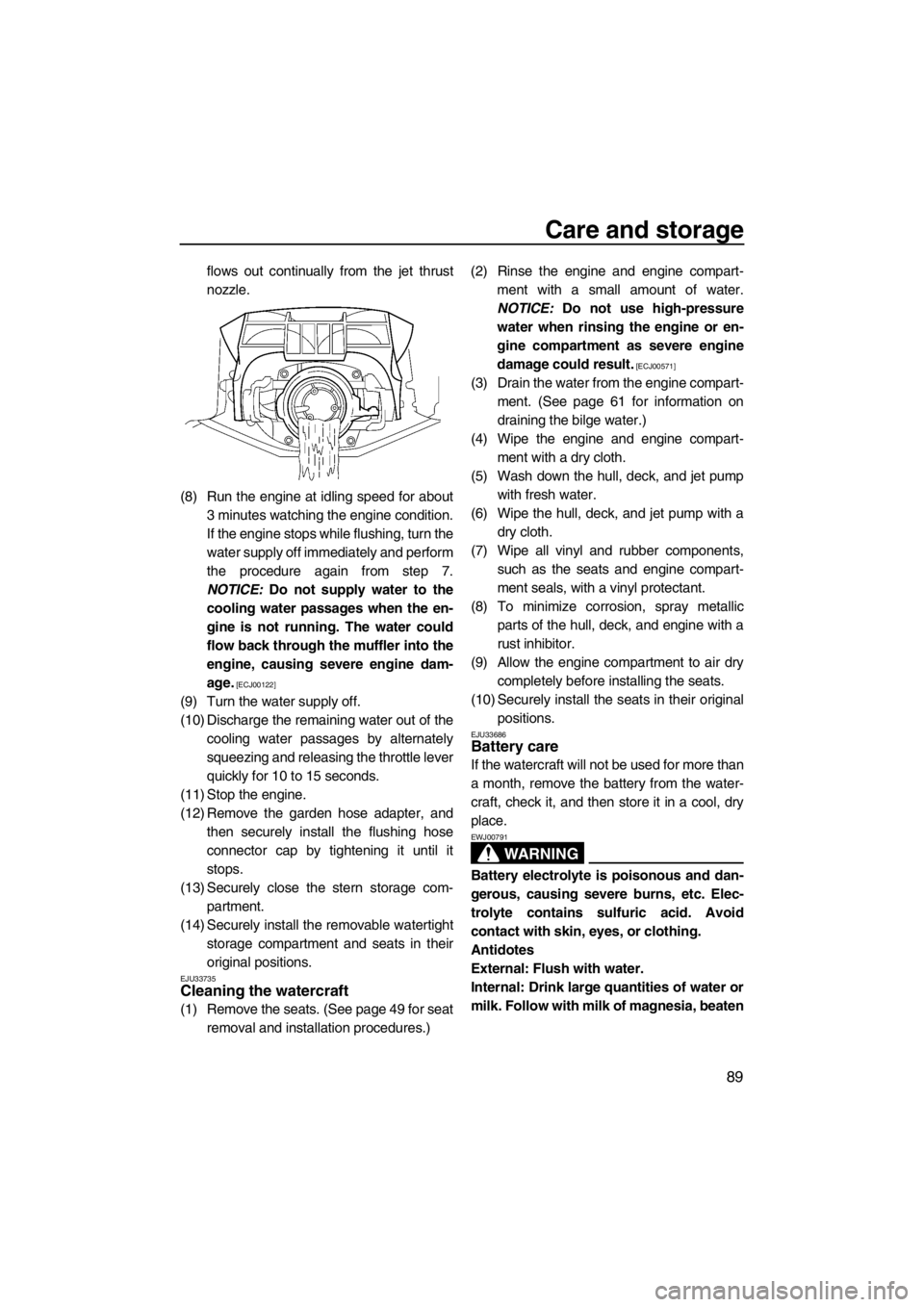
Care and storage
89
flows out continually from the jet thrust
nozzle.
(8) Run the engine at idling speed for about
3 minutes watching the engine condition.
If the engine stops while flushing, turn the
water supply off immediately and perform
the procedure again from step 7.
NOTICE: Do not supply water to the
cooling water passages when the en-
gine is not running. The water could
flow back through the muffler into the
engine, causing severe engine dam-
age.
[ECJ00122]
(9) Turn the water supply off.
(10) Discharge the remaining water out of the
cooling water passages by alternately
squeezing and releasing the throttle lever
quickly for 10 to 15 seconds.
(11) Stop the engine.
(12) Remove the garden hose adapter, and
then securely install the flushing hose
connector cap by tightening it until it
stops.
(13) Securely close the stern storage com-
partment.
(14) Securely install the removable watertight
storage compartment and seats in their
original positions.
EJU33735Cleaning the watercraft
(1) Remove the seats. (See page 49 for seat
removal and installation procedures.)(2) Rinse the engine and engine compart-
ment with a small amount of water.
NOTICE: Do not use high-pressure
water when rinsing the engine or en-
gine compartment as severe engine
damage could result.
[ECJ00571]
(3) Drain the water from the engine compart-
ment. (See page 61 for information on
draining the bilge water.)
(4) Wipe the engine and engine compart-
ment with a dry cloth.
(5) Wash down the hull, deck, and jet pump
with fresh water.
(6) Wipe the hull, deck, and jet pump with a
dry cloth.
(7) Wipe all vinyl and rubber components,
such as the seats and engine compart-
ment seals, with a vinyl protectant.
(8) To minimize corrosion, spray metallic
parts of the hull, deck, and engine with a
rust inhibitor.
(9) Allow the engine compartment to air dry
completely before installing the seats.
(10) Securely install the seats in their original
positions.
EJU33686Battery care
If the watercraft will not be used for more than
a month, remove the battery from the water-
craft, check it, and then store it in a cool, dry
place.
WARNING
EWJ00791
Battery electrolyte is poisonous and dan-
gerous, causing severe burns, etc. Elec-
trolyte contains sulfuric acid. Avoid
contact with skin, eyes, or clothing.
Antidotes
External: Flush with water.
Internal: Drink large quantities of water or
milk. Follow with milk of magnesia, beaten
UF2S70E0.book Page 89 Wednesday, December 7, 2011 3:56 PM
Page 96 of 116
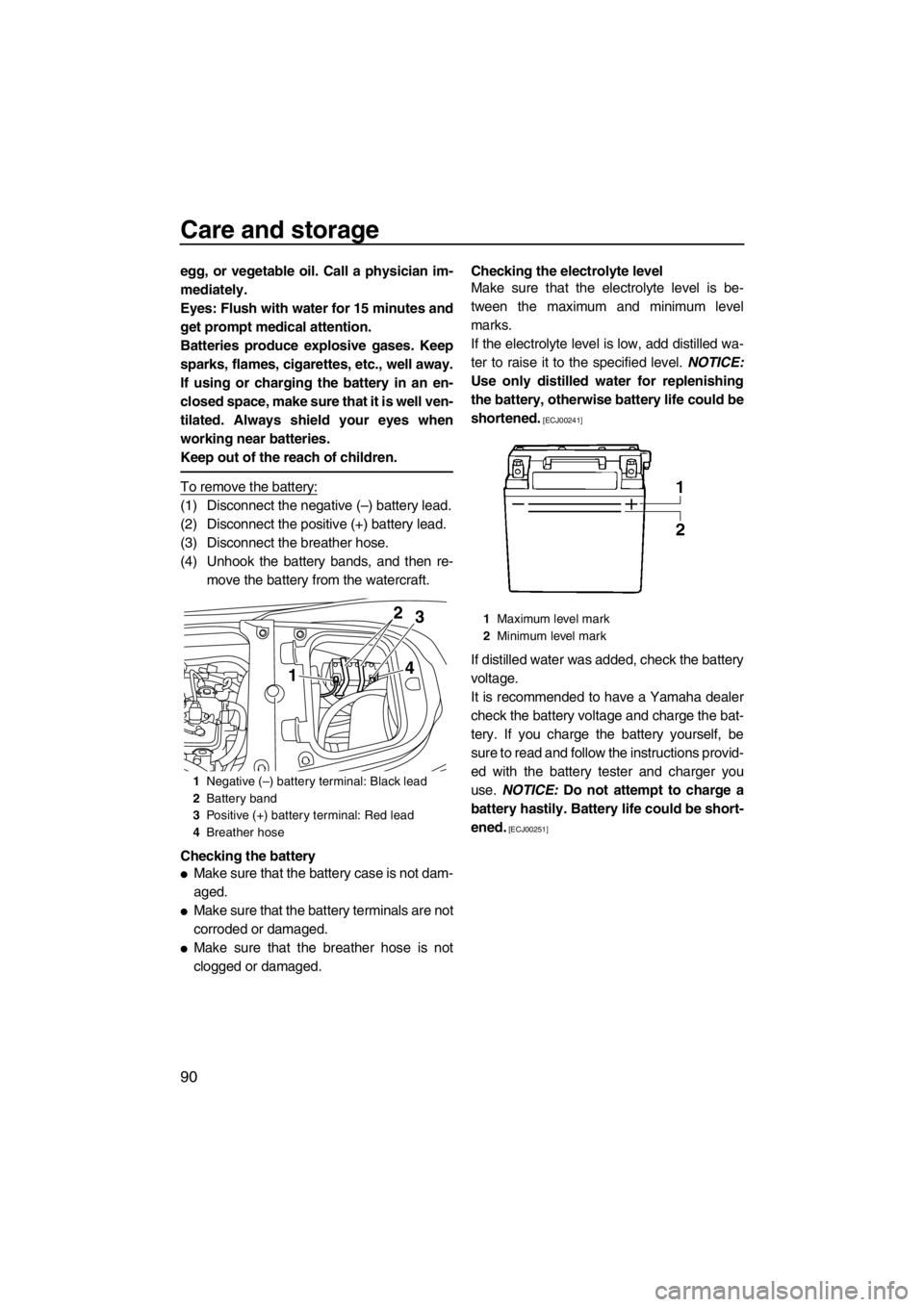
Care and storage
90
egg, or vegetable oil. Call a physician im-
mediately.
Eyes: Flush with water for 15 minutes and
get prompt medical attention.
Batteries produce explosive gases. Keep
sparks, flames, cigarettes, etc., well away.
If using or charging the battery in an en-
closed space, make sure that it is well ven-
tilated. Always shield your eyes when
working near batteries.
Keep out of the reach of children.
To remove the battery:
(1) Disconnect the negative (–) battery lead.
(2) Disconnect the positive (+) battery lead.
(3) Disconnect the breather hose.
(4) Unhook the battery bands, and then re-
move the battery from the watercraft.
Checking the battery
●Make sure that the battery case is not dam-
aged.
●Make sure that the battery terminals are not
corroded or damaged.
●Make sure that the breather hose is not
clogged or damaged.Checking the electrolyte level
Make sure that the electrolyte level is be-
tween the maximum and minimum level
marks.
If the electrolyte level is low, add distilled wa-
ter to raise it to the specified level. NOTICE:
Use only distilled water for replenishing
the battery, otherwise battery life could be
shortened.
[ECJ00241]
If distilled water was added, check the battery
voltage.
It is recommended to have a Yamaha dealer
check the battery voltage and charge the bat-
tery. If you charge the battery yourself, be
sure to read and follow the instructions provid-
ed with the battery tester and charger you
use. NOTICE: Do not attempt to charge a
battery hastily. Battery life could be short-
ened.
[ECJ00251]
1Negative (–) battery terminal: Black lead
2Battery band
3Positive (+) battery terminal: Red lead
4Breather hose
143 2
1Maximum level mark
2Minimum level mark
UF2S70E0.book Page 90 Wednesday, December 7, 2011 3:56 PM
Page 97 of 116
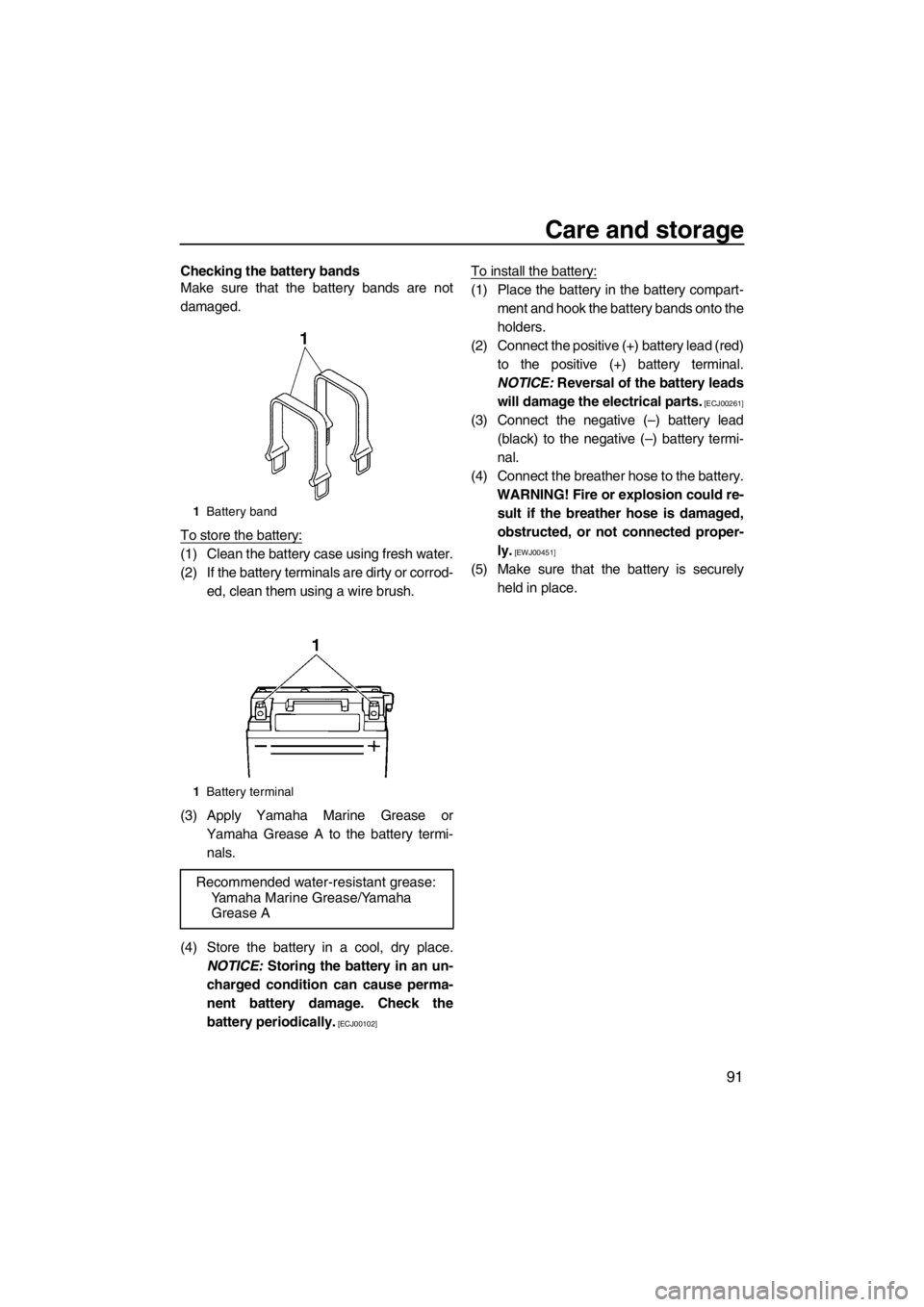
Care and storage
91
Checking the battery bands
Make sure that the battery bands are not
damaged.
To store the battery:
(1) Clean the battery case using fresh water.
(2) If the battery terminals are dirty or corrod-
ed, clean them using a wire brush.
(3) Apply Yamaha Marine Grease or
Yamaha Grease A to the battery termi-
nals.
(4) Store the battery in a cool, dry place.
NOTICE: Storing the battery in an un-
charged condition can cause perma-
nent battery damage. Check the
battery periodically.
[ECJ00102]
To install the battery:
(1) Place the battery in the battery compart-
ment and hook the battery bands onto the
holders.
(2) Connect the positive (+) battery lead (red)
to the positive (+) battery terminal.
NOTICE: Reversal of the battery leads
will damage the electrical parts.
[ECJ00261]
(3) Connect the negative (–) battery lead
(black) to the negative (–) battery termi-
nal.
(4) Connect the breather hose to the battery.
WARNING! Fire or explosion could re-
sult if the breather hose is damaged,
obstructed, or not connected proper-
ly.
[EWJ00451]
(5) Make sure that the battery is securely
held in place.
1Battery band
1Battery terminal
Recommended water-resistant grease:
Yamaha Marine Grease/Yamaha
Grease A
UF2S70E0.book Page 91 Wednesday, December 7, 2011 3:56 PM
Page 98 of 116
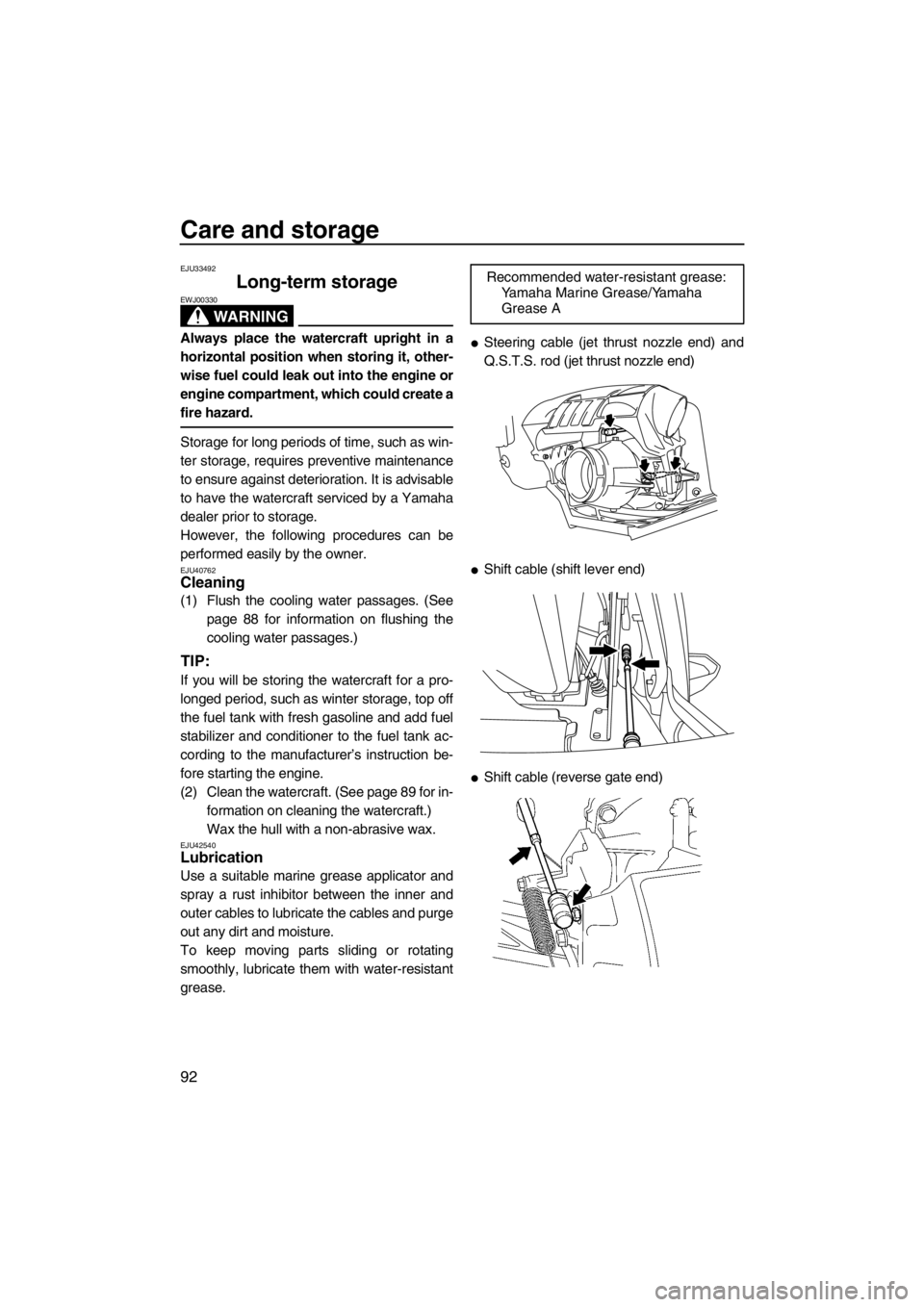
Care and storage
92
EJU33492
Long-term storage
WARNING
EWJ00330
Always place the watercraft upright in a
horizontal position when storing it, other-
wise fuel could leak out into the engine or
engine compartment, which could create a
fire hazard.
Storage for long periods of time, such as win-
ter storage, requires preventive maintenance
to ensure against deterioration. It is advisable
to have the watercraft serviced by a Yamaha
dealer prior to storage.
However, the following procedures can be
performed easily by the owner.
EJU40762Cleaning
(1) Flush the cooling water passages. (See
page 88 for information on flushing the
cooling water passages.)
TIP:
If you will be storing the watercraft for a pro-
longed period, such as winter storage, top off
the fuel tank with fresh gasoline and add fuel
stabilizer and conditioner to the fuel tank ac-
cording to the manufacturer’s instruction be-
fore starting the engine.
(2) Clean the watercraft. (See page 89 for in-
formation on cleaning the watercraft.)
Wax the hull with a non-abrasive wax.
EJU42540Lubrication
Use a suitable marine grease applicator and
spray a rust inhibitor between the inner and
outer cables to lubricate the cables and purge
out any dirt and moisture.
To keep moving parts sliding or rotating
smoothly, lubricate them with water-resistant
grease.
●Steering cable (jet thrust nozzle end) and
Q.S.T.S. rod (jet thrust nozzle end)
●Shift cable (shift lever end)
●Shift cable (reverse gate end)Recommended water-resistant grease:
Yamaha Marine Grease/Yamaha
Grease A
UF2S70E0.book Page 92 Wednesday, December 7, 2011 3:56 PM
Page 99 of 116

Care and storage
93
EJU40811Rustproofing
Spray metallic parts of the hull, deck, and en-
gine with a rust inhibitor.
Have a Yamaha dealer rustproof the internal
engine components.
UF2S70E0.book Page 93 Wednesday, December 7, 2011 3:56 PM
Page 100 of 116
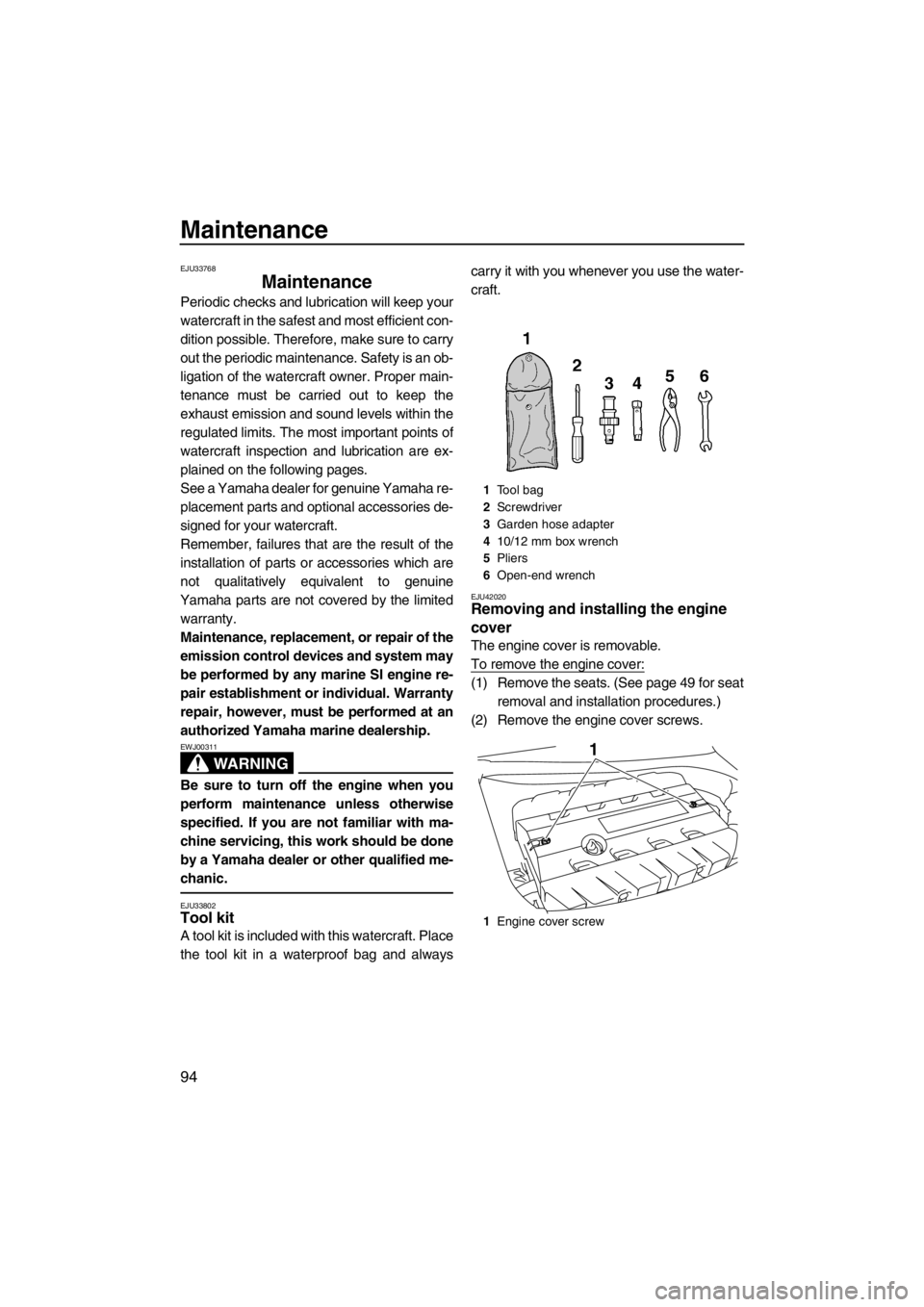
Maintenance
94
EJU33768
Maintenance
Periodic checks and lubrication will keep your
watercraft in the safest and most efficient con-
dition possible. Therefore, make sure to carry
out the periodic maintenance. Safety is an ob-
ligation of the watercraft owner. Proper main-
tenance must be carried out to keep the
exhaust emission and sound levels within the
regulated limits. The most important points of
watercraft inspection and lubrication are ex-
plained on the following pages.
See a Yamaha dealer for genuine Yamaha re-
placement parts and optional accessories de-
signed for your watercraft.
Remember, failures that are the result of the
installation of parts or accessories which are
not qualitatively equivalent to genuine
Yamaha parts are not covered by the limited
warranty.
Maintenance, replacement, or repair of the
emission control devices and system may
be performed by any marine SI engine re-
pair establishment or individual. Warranty
repair, however, must be performed at an
authorized Yamaha marine dealership.
WARNING
EWJ00311
Be sure to turn off the engine when you
perform maintenance unless otherwise
specified. If you are not familiar with ma-
chine servicing, this work should be done
by a Yamaha dealer or other qualified me-
chanic.
EJU33802Tool kit
A tool kit is included with this watercraft. Place
the tool kit in a waterproof bag and alwayscarry it with you whenever you use the water-
craft.
EJU42020Removing and installing the engine
cover
The engine cover is removable.
To remove the engine cover:
(1) Remove the seats. (See page 49 for seat
removal and installation procedures.)
(2) Remove the engine cover screws.
1Tool bag
2Screwdriver
3Garden hose adapter
410/12 mm box wrench
5Pliers
6Open-end wrench
1Engine cover screw
1
UF2S70E0.book Page 94 Wednesday, December 7, 2011 3:56 PM